
The Legend of Zelda is an action-adventure game franchise created by the Japanese game designers Shigeru Miyamoto and Takashi Tezuka. It is primarily developed and published by Nintendo, although some portable installments and re-releases have been outsourced to Capcom, Vanpool, and Grezzo. The gameplay incorporates action-adventure and elements of action RPG games.
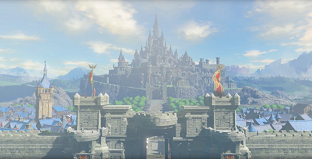
The Legend of Zelda is a video game franchise created by Japanese video game designers Shigeru Miyamoto and Takashi Tezuka. It is mainly developed and published by Nintendo. The universe of the Legend of Zelda series consists of a variety of lands, the most predominant being Hyrule. The franchise is set within a fantasy world that is reminiscent of medieval Europe and consists of several recurring locations, races and creatures. The most prominent population in the series are the Hylians, a humanoid race with elfin features, that are identifiable by their long, pointed ears. The game world is accompanied by a detailed fictional lore that contains a creation myth, several constructed languages, the most prominent being Hylian, and a fictional universal currency called the rupee. Most games in The Legend of Zelda series follow a similar storyline, which involves the protagonist Link battling monsters to save Princess Zelda and defeat an evil villain, which is often the series' main antagonist, Ganon. Nintendo developed the fictional lore into a complex timeline that spans across the series and chronicles thousands of years of fictional history.

Shigeru Miyamoto is a Japanese video game designer, producer and game director at Nintendo, where he serves as one of its representative directors. Widely regarded as one of the most accomplished and influential designers in the history of video games, he is the creator of some of the most acclaimed and best-selling game franchises of all time, including Mario,The Legend of Zelda, Donkey Kong, Star Fox and Pikmin.

The Legend of Zelda: Ocarina of Time is an action-adventure game developed and published by Nintendo for the Nintendo 64. It was released in Japan and North America in November 1998, and in PAL regions the following month. Ocarina of Time is the first game in The Legend of Zelda series with 3D graphics.

The Legend of Zelda: Majora's Mask is a 2000 action-adventure game developed and published by Nintendo for the Nintendo 64 home console. It was released worldwide in 2000 as a main installment in The Legend of Zelda series and was the second to use 3D graphics, following 1998's The Legend of Zelda: Ocarina of Time, to which it is a direct sequel. Designed by a creative team led by Eiji Aonuma, Yoshiaki Koizumi, and Shigeru Miyamoto, Majora's Mask was completed in less than two years. It featured enhanced graphics and several gameplay changes from its predecessor, though it reused a number of elements and character models, which the game's creators called a creative decision made necessary by time constraints.
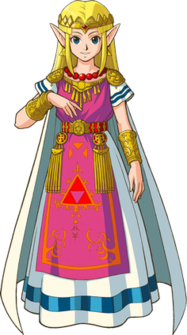
Princess Zelda is the titular character in Nintendo's The Legend of Zelda video game series. She was created by Shigeru Miyamoto and introduced in the original 1986 game The Legend of Zelda. She is one of the central characters in the series, having appeared in multiple incarnations over more than three decades. In the fictional storyline of the series, she is a princess of the kingdom of Hyrule, an associate of the protagonist Link, and bearer of the Triforce of Wisdom.
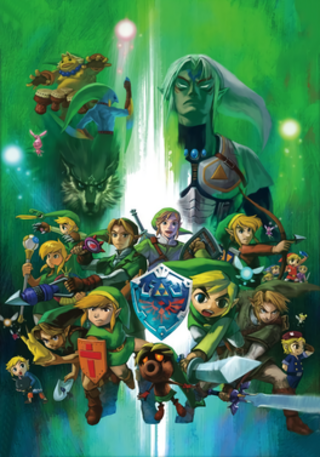
Link is the protagonist of Nintendo's video game franchise The Legend of Zelda. He was created by Japanese video game designer Shigeru Miyamoto. Link was introduced as the hero of the original 1986 The Legend of Zelda video game and has appeared in a total of 19 entries in the series, as well as a number of spin-offs. Common elements in the series include Link travelling through Hyrule whilst exploring dungeons, battling creatures and solving puzzles until he eventually defeats the series' primary antagonist, Ganon, and saves Princess Zelda.

Ganon is a fictional character and the primary antagonist of Nintendo's The Legend of Zelda video game series and franchise, as well as the final boss in many Zelda titles. A massive and malevolent creature, he first appeared in the original game, The Legend of Zelda (1986), and has since appeared in the majority of the games in the series. Ganon is the archenemy of the protagonist Link and the leader of the Gerudo, a race of humanoid desert nomads. In his Gerudo form, from which he can transmogrify, he is known as Ganondorf.
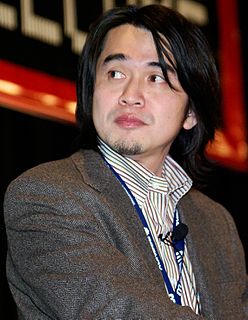
Yoshiaki Koizumi is a Japanese video game designer, director, and producer, and business executive. He is a senior executive officer at Nintendo, where he is known for his work within their Mario and The Legend of Zelda series.

Epona is a recurring fictional horse in The Legend of Zelda series of video games that debuted in The Legend of Zelda: Ocarina of Time. She was created by Yoshiaki Koizumi as the main form of transportation and steed of Link, the series protagonist. Her name is derived from the Celtic goddess of horses of the same name. Epona appears in several main titles in The Legend of Zelda series, including Majora's Mask, Twilight Princess and Breath of the Wild. She also appears in the spin-off title Hyrule Warriors and other game series.

Navi is a fictional fairy who acts as series protagonist Link's navigator throughout the 1998 Nintendo 64 video game The Legend of Zelda: Ocarina of Time. She was voiced by Kaori Mizuhashi. Navi performs a variety of functions within the game, including being a companion and guide to Link, providing the player with advice and being a focal point for the game's Z-lock targeting combat system. She has been widely criticised by players and critics for her repetitive interruptions in gameplay, particularly with the prompt "Hey! Listen!".
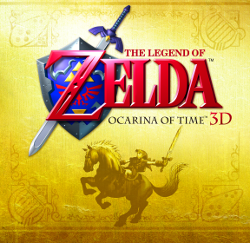
The Legend of Zelda: Ocarina of Time 3D is an action-adventure game developed by Grezzo and published by Nintendo for the Nintendo 3DS handheld game console. The game was released in June 2011. A remake of the original 1998 Nintendo 64 game, it features updated graphics, stereoscopic 3D effects, and mirrored versions of the rearranged dungeons from Ocarina of Time Master Quest. The game was released in June 2011, with digital release via the Nintendo eShop arriving in 2012.
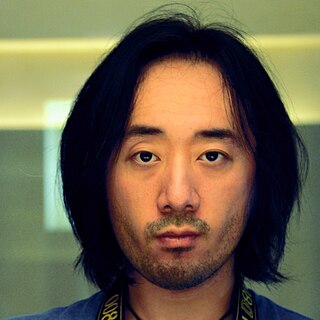
Ge Wang is a Chinese American professor, musician, computer scientist, designer, and author, known for inventing the ChucK audio programming language and for being the co-founder, chief technology officer (CTO), and chief creative officer (CCO) of Smule, a company making iPhone and iPad music apps. He also helped create the Princeton Laptop Orchestra and later founded its Stanford counterpart Stanford Laptop Orchestra, as well as the Stanford Mobile Phone Orchestra. Wang is the designer of the Ocarina and Magic Piano iPhone apps. Wang is currently an associate professor at Stanford University’s Center for Computer Research in Music and Acoustics (CCRMA). Wang is the author of Artful Design: Technology in Search of the Sublime , a book on design and technology, art and life, created entirely in the format of a photo comic book, published by Stanford University Press in 2018.
Narcissa Wright is an American speedrunner and co-founder of the website SpeedRunsLive, which allows speedrunners to race with one another in real time. She previously held the records for the fastest completion of The Legend of Zelda: The Wind Waker on the GameCube, The Legend of Zelda: Ocarina of Time on the iQue Player, Paper Mario on the Wii using Virtual Console, and Castlevania 64 on the Nintendo 64.

"It's dangerous to go alone! Take this." is a quotation from the 1986 video game The Legend of Zelda for the Nintendo Entertainment System (NES). It is spoken by an unnamed old man, met in the cave at the start of the game, who gives the player-character Link a sword to aid his quest to defeat Ganon and rescue Princess Zelda. The quote has been referenced in video gaming and other media, has become an Internet meme, and has been established in pop culture.
Ocarina (2008) is an app by Smule. It was followed by Ocarina 2 (2012). Both apps were designed by Ge Wang.

The Legend of Zelda is a high-fantasy video game series created by Japanese game designers Shigeru Miyamoto and Takashi Tezuka. It is primarily developed and published by Nintendo, although some portable installments have been outsourced to Capcom, Vanpool and Grezzo. The series' gameplay incorporates elements of action, adventure and puzzle-solving games.

The Water Temple is an area from the 1998 Nintendo 64 video game The Legend of Zelda: Ocarina of Time. It is the sixth dungeon encountered in the game. It was created by Ocarina of Time director Eiji Aonuma, who was inspired by his love of diving. It has players raising and lowering water levels to access different areas while utilizing a pair of Iron Boots to sink to the bottom. The difficulty of navigation combined with the cumbersome nature of using the Iron Boots led to several changes to the dungeon to assist players in the 2011 remake of Ocarina of Time, The Legend of Zelda: Ocarina of Time 3D. The difficulty players faced also caused Aonuma to apologize for the issues, while noting that the dungeon was not difficult so much as it was frustrating. Despite the criticism, some critics have been more forgiving, praising the Water Temple for its complexities.
Zfg is an American speedrunner and streamer known for his The Legend of Zelda: Ocarina of Time gameplay. He has held various records in speedrunning the game and its alternative version Master Quest, most notably the 100% completion category for the original game, which he had held the record for since mid-2015. He was the first person to complete Ocarina of Time to 100% in under four hours. He currently holds the record in the 100% SRM category with a time of 3 hours, 3 minutes and 32 seconds, as of March 2021.















